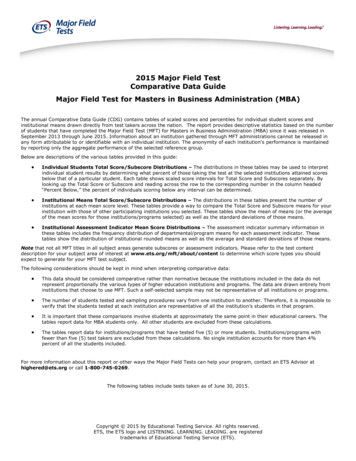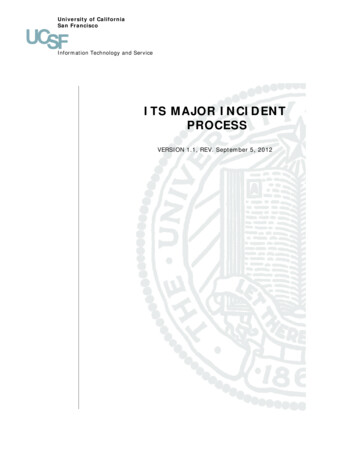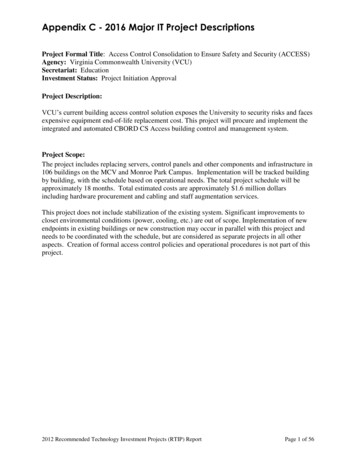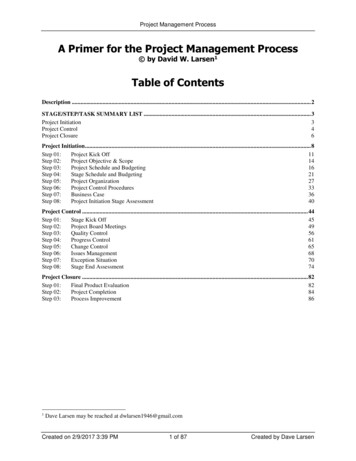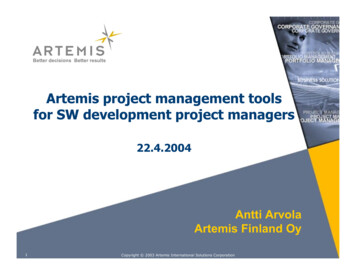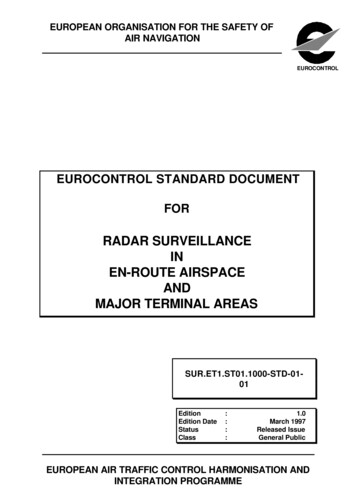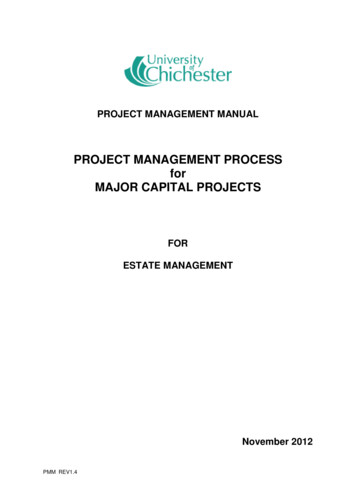
Transcription
PROJECT MANAGEMENT MANUALPROJECT MANAGEMENT PROCESSforMAJOR CAPITAL PROJECTSFORESTATE MANAGEMENTNovember 2012PMM REV1.4
CONTENTSINTRODUCTIONPROJECT MANAGEMENT PROCESS 102.112.12STAGE ZEROPROJECT CONCEPT AND DEFINITIONIntroductionIdentify Stakeholder/User NeedsPrepare a Statement of NeedPreliminary Business CasePrepare Outline Project BriefAppoint Project TeamDevelop Preliminary Business CaseGateway 1 – Approval to Proceed with Feasibility StageSTAGE ONEFEASIBILITY STAGE (RIBA Stages A – C)IntroductionSite Constraints and OpportunitiesSelect and Appoint ConsultantsDevelop Project BriefPreliminary Project Master ProgrammeOptions, Appraisal and SelectionFunding Investment and AppraisalProject Organisation and ControlProcurement StrategyCost Planning and Cost ManagementPrepare Full Business CaseGateway 2 - Approval to Proceed with Detailed DesignSTAGE TWODETAILED DESIGN (RIBA Stages D – G)IntroductionPrepare Detailed Consultant BriefSelect Tender ListTenderEvaluate TendersApproval to ProceedAppoint ConsultantsDetailed DesignDesign Team BriefingDetailed ProposalsFinal ProposalsProduction InformationVariations to Traditional Forms of ContractGateway 3 – Approval to Proceed with Tender StageProject Management Manual (Project Management Process)S:\Departments\Estate Management\Projects\PMM REV1.4.doc
84.94.104.115.05.15.25.35.45.55.65.75.85.9STAGE THREEPROCURE CONTRACT WORKS (RIBA Stages K)IntroductionSelect Tender ListPrepare Tender DocumentsGateway 3 - Approval to Proceed to TenderTenderEvaluate TendersGateway 4 - Approval to Contractual CommitmentAppoint ContractorSTAGE FOURIMPLEMENTATION (RIBA Stage K)IntroductionPre-Contract MeetingContractual ArrangementsHealth and Safety ManagementControl SystemsTeamwork, Partnering and IncentivesMonitoring Design and ConstructionCost ManagementQuality ManagementProgramme ManagementRisk ManagementContractual Claims and Dispute ManagementSTAGE 5COMMISSION, COMPLETION AND HANDOVER (RIBA Stage L)IntroductionPreparation for Commission, Completion and HandoverImplement CommissioningImplement Works CompletionImplement Hand-overPost-Handover ActivitiesProject AuditCost and Time StudyHuman Resources AspectsPerformance Study – Output Assessment ReportGLOSSARY OF TERMSSUSTAINABILITY MEASURESProject Management Manual (Project Management Process)S:\Departments\Estate Management\Projects\PMM REV1.4.doc
INTRODUCTIONINTRODUCTIONOverviewThis Project Management Manual provides best practice guidance and model documents,which will assist University staff and its Consultants and Contractors to perform their duties,with the express intention of standardising the project management process andencouraging the use of best practice.The Manual is divided into two Volumes. Volume one contains the Project ManagementProcess manual. Volume 2 contains all the ‘standard’ and amended forms that are usedmost regularly by the University in addition to standard model bonds and warranties andforms of contract that are not included.The Executive Synopsis provides an overview of the project management process and isintended for use by Senior Managers and Development Managers who need anunderstanding of the project management process and its role within the University but donot need to be familiar with the detailed process.The Project Management Process manual, which is this document, is intended to be theProject Manager’s main source of information and guidance. It contains a detaileddescription of, and a flow chart for, the project management process and incorporates modelforms, checklists and templates.Scope of the Project Management Process ManualThis document describes the route to be taken in the delivery of a project and is structuredon the presumption that the project is for the delivery or improvement of a built asset orfacility.It is appreciated that many projects do not necessarily directly result in a changed physicalasset. For example, actions taken by the University that either change the market’sperception of an area, or facilitate implementation of a project by another body, that couldnot have happened without a contribution in kind by the University, are all recognised asprojects.A project is therefore interpreted as any action requiring capital expenditure or other input bythe University that results in an improvement in an asset or other measurable output.A project can therefore include such diverse matters as: The execution of improvement works to the Estate within the University via capitalfundingThe master-planning of a designated area, including land not in the University’sownershipConsideration of specific studies to review the social, environmental and economicimpact of a range of optionsThe acquisition, assembly, exchange or rationalisation and disposal of the University’sestate to facilitate regeneration by othersFor the first time the University is asked to consider Benchmarking its own performance inthe delivery of what it does, to assess the current position, ascertain if it is getting better andthe rate at which it is improving. It is proposed that Project Managers select and use themost appropriate portion of this manual to assist in the effective delivery of their project.Project Management Manual (Project Management Process)1
INTRODUCTIONIt is also worth noting that this is a ‘best practice’ document and is based upon the TreasuryProcurement Guidelines. The intent was to provide transparent, auditable procedures thatprovide best value. There are alternative methods to those detailed in this document but theProject Team is strongly advised to follow the procedures outlined in this document. Bydoing so it will be able to demonstrate it is following best practice.Project Management Process Manual StructureThe first 5 sections of this manual detail the project management process in a logicalsequence from Project Concept to Project Review and Close Out.It should be noted that although Sections 1-5 and their sub-sections are listed sequentially,as far as possible in the ‘chronological order’ of a typical project, the sequence does nothave to be followed rigidly. It is expected that many tasks will be carried out simultaneouslyand the order of some tasks may be changed to suit the requirements of individual projects.The document uses two flowcharts. The first, called the Project Management Process StageMap, illustrates the relevant Procedure to be followed whilst the second is a the visualrepresentation of the Capital Project, illustrating the route through each of these six stages.The forms and checklists contained in the appendices are for guidance only and suitablealternatives may be used, but these should be used as a basic minimum.Project Management Manual (Project Management Process)2
PROJECT MANAGEMENT PROCESS FLOWCHARTSPROJECT MANAGEMENT PROCESS MAPProject Management Manual (Project Management Process)3
PROJECT MANAGEMENT PROCESS FLOWCHARTSSTAGES OF CAPITAL PROJECTSProject Management Manual (Project Management Process)4
STAGE ZERO0.0PROJECT CONCEPT AND DEFINITIONIntroductionProject Concept and Definition is the starting point for all projects. The objective ofProject Concept and Definition is, within the context of the University Corporate Plan,to identify the potential need for a project, define those needs and decide whether ornot it is worth investing resources in finding a solution to those needs. It should benoted that a project within the context of the University will be broadly defined andcould include master-planning, urban design, town planning studies, land acquisition,land disposal or physical works such as site clearance, infrastructure works, civilengineering, building, decontamination, environmental improvement or landscaping.The process of project concept and definition involves the assembly of all relevantinformation to enable the Investment Decision-Maker to make an informedjudgement as to whether the project is feasible and should be considered further. AProject Sponsor will carry this out with the advice and support of a Project Manager.The project at this stage exists only in the form of a preliminary business case thatwill be presented to the Investment Decision Maker.To produce a successful project some stages of the project will be iterative so thatsome problems or risks become designed out, and what moves forward is a welldefined project with all parties understanding their respective risks, liabilities andresponsibilities.Time spent in preparation of a project is very rarely wasted. The impact of change atthis point will have least impact in cost on time of delivery.0.1Identify Stakeholder/User NeedsPotential projects are identified either within the University, usually by the InvestmentDecision-Maker or the Project Sponsor, or by external organisations such as LocalAuthorities, Urban Regeneration organisations, Government Departments ordevelopers.The first step in any project is to identify the need for a project: Identify the Stakeholders or users (both actual and potential)Clearly identify their needsPresent clear reasons for meeting those needsEvery project must have a raison d’être. The clear identification of user needs is thefirst step in identifying the need for a project and the direction in which it should go.The project itself will not be the solution to the users’ needs it is merely themechanism for delivering the solution.The user needs and reasons for meeting those needs must be in line with theUniversity’s corporate objectives, such as providing grants for businesses to createor secure jobs in a particular geographical area or remediating land to encouragedevelopment or other recognised output or deliverable.Project Management Manual (Project Management Process)5
The needs can only be identified through methodical but tactful interrogation of theStakeholders or users. To improve the likelihood of obtaining all the relevantinformation this should be carried out, either in writing or verbally then confirmed inwriting, by an experienced individual who knows what questions to ask.0.2Prepare a Statement of NeedIf the potential project falls within the policy and/or funding capability of the Universitythe Project Sponsor should prepare a Statement of Need. The scope and scale of aproject will determine the breadth of such a statement of need.The purpose of this stage is to identify whether it is likely that a project will berequired. The statement of need is a distillation of the ideas generated by theidentification of user needs and should provide clear answers to the followingquestions:What is the existing situation? (Where are we now?)What situation do we want to create? (Where do we want to be?)What product do we need?)What are the characteristics of the product?) (How do we getWhat are the costs and benefits of this product?) there?)What is the most efficient way of delivering this product? )Always consider a ‘do nothing’ option as a comparison.Value ManagementIf value management techniques are being employed on a project, apply them evenat this early stage. The focus should be on both strategic issues and user andStakeholder requirements. The techniques employed could include a FunctionAnalysis.Note that in all subsequent sections this manual assumes value management will beused.For further information on Value Management refer to Section 15.0.3Preliminary Business CaseThe development and production of a Business Case is an iterative process ratherthan a single task that only needs to be visited once. The development of thebusiness case is a target for which a plan needs to be developed.What needs to be included in a business case is scheduled in Section 1.6.Having identified the stakeholder and the user needs it is essential to identify how thebusiness case will be developed, what information needs to be assembled, how thatinformation will be obtained and who will complete each task.It is necessary at this point to consider the assembly of a project team, to bring thatteam together and assign tasks or duties.Project Management Manual (Project Management Process)6
0.4Prepare Outline Project BriefTo be successful a project should fulfil the objectives defined at the outset. It isessential, therefore, that those objectives and their relative priority are clearlyestablished at an early stage. Clear objectives form the platform for effectivedevelopment of the project and provide a baseline reference if the project directionbecomes unclear.If the scope of the project is particularly complex then it may be beneficial to appointa Project Manager at this stage to use his or her expertise to help define theobjectives and later to help identify and assess the options for achieving thoseobjectives.The outline project brief will not only identify project objectives that reflect theUniversity’s objectives but it will also identify the benefits and also the constraints,such as time, cost, performance and location.0.5Appoint Project TeamAt some point it will be necessary to begin drawing together a Project Team.Depending on factors such as the size and complexity of the project this may occurduring the Project Concept and Definition stage or it may not occur until later in theproject lifecycle. This section is included here since this is the earliest stage theappointment of the Project Team may occur. Refer back to this section if the ProjectTeam will be appointed during a later stage.Appoint an in-house Project Team to fulfil the roles listed below: Investment Decision Maker/Project OwnerProject SponsorDevelopment ManagerProject Manager (may be in-house or an external appointment)As the project develops the Project Team will expand to include the designers, otherspecialists and the Contractor.When appointing individuals, consider the following: Relevant experienceTechnical q
Project Management Manual (Project Management Process) 2 It is also worth noting that this is a ‘best practice’ document and is based upon the Treasury Procurement Guidelines. The intent was to provide transparent, auditable procedures that provide best value. There are alternative methods to those detailed in this document but the Project Team is strongly advised to follow the procedures .
